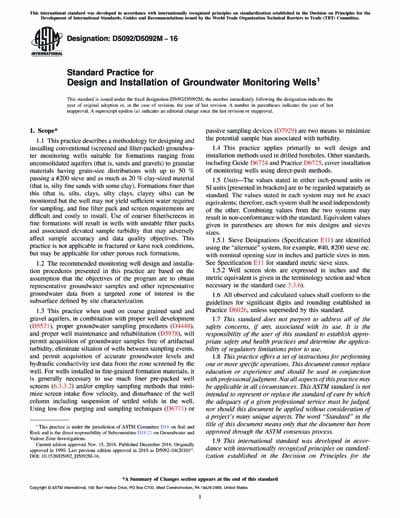Historical
ASTM D5092/D5092M-16
Standard Practice for Design and Installation of Groundwater Monitoring Wells
1.1 This practice describes a methodology for designing and installing conventional (screened and filter-packed) groundwater monitoring wells suitable for formations ranging from unconsolidated aquifers (that is, sands and gravels) to granular materials having grain-size distributions with up to 50 % passing a #200 sieve and as much as 20 % clay-sized material (that is, silty fine sands with some clay). Formations finer than this (that is, silts, clays, silty clays, clayey silts) can be monitored but the well may not yield sufficient water required for sampling, and fine filter pack and screen requirements are difficult and costly to install. Use of coarser filter/screens in fine formations will result in wells with unstable filter packs and associated elevated sample turbidity that may adversely affect sample accuracy and data quality objectives. This practice is not applicable in fractured or karst rock conditions, but may be applicable for other porous rock formations.
1.2 The recommended monitoring well design and installation procedures presented in this practice are based on the assumption that the objectives of the program are to obtain representative groundwater samples and other representative groundwater data from a targeted zone of interest in the subsurface defined by site characterization.
1.3 This practice when used on coarse grained sand and gravel aquifers, in combination with proper well development (D5521), proper groundwater sampling procedures (D4448), and proper well maintenance and rehabilitation (D5978), will permit acquisition of groundwater samples free of artifactual turbidity, eliminate siltation of wells between sampling events, and permit acquisition of accurate groundwater levels and hydraulic conductivity test data from the zone screened by the well. For wells installed in fine-grained formation materials, it is generally necessary to use much finer pre-packed well screens (6.3.3.2) and/or employ sampling methods that minimize screen intake flow velocity, and disturbance of the well column including suspension of settled solids in the well. Using low-flow purging and sampling techniques (D6771) or passive sampling devices (D7929) are two means to minimize the potential sample bias associated with turbidity.
1.4 This practice applies primarily to well design and installation methods used in drilled boreholes. Other standards, including Guide D6724 and Practice D6725, cover installation of monitoring wells using direct-push methods.
ASTM International [astm]

